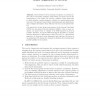122 search results - page 1 / 25 » Protein Fold Recognition using Residue-Based Alignments of S... |
ICASSP
2007
IEEE
14 years 1 months ago
2007
IEEE
Protein structure prediction aims to determine the three-dimensional structure of proteins form their amino acid sequences. When a protein does not have similarity (homology) to a...
BMCBI
2006
13 years 6 months ago
2006
Background: The majority of peptide bonds in proteins are found to occur in the trans conformation. However, for proline residues, a considerable fraction of Prolyl peptide bonds ...
BMCBI
2008
13 years 7 months ago
2008
Background: Residue depth allows determining how deeply a given residue is buried, in contrast to the solvent accessibility that differentiates between buried and solvent-exposed ...
RECOMB
2009
Springer
14 years 7 months ago
2009
Springer
Abstract. Accurate comparative analysis tools for low-homology proteins remains a difficult challenge in computational biology, especially sequence alignment and consensus folding ...
COMPLIFE
2005
Springer
14 years 11 days ago
2005
Springer
Abstract. Most software tools in homology recognition on proteins answer only a few specific questions, often leaving not much room for the interpretation of the results. We devel...

